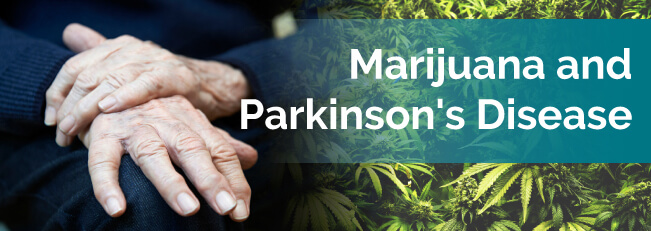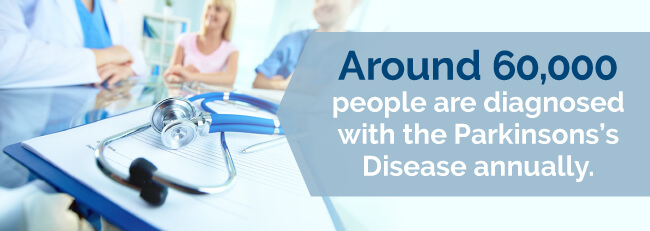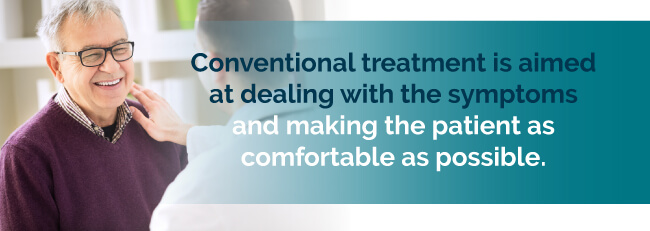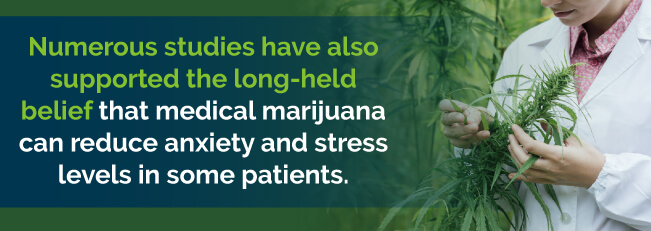
A disorder of the nervous system, Parkinson’s disease affects a person’s ability to move. Since it is a progressive disease, Parkinson’s grows worse with time. In many people, symptoms start out small and subtle but begin to interfere more and more with daily life. In a healthy brain, brain cells produce a chemical called dopamine. Dopamine is responsible for relaying messages within the brain that control movement in the human body. When these cells are damaged, the signs of Parkinson’s Disease begin to show.
Some treatments are available for Parkinson’s, but there is no cure. As medical marijuana becomes legal in more and more states, physicians and researchers are looking more closely at the potential benefits of medical cannabis for Parkinson’s disease.
The brain is composed of gray and white matter containing millions of nerve cells. These nerve cells, or neurons, communicate through the release of chemicals called neurotransmitters. Once a neuron is stimulated the neurotransmitter is released from the neuron and it cross a gap called a synapse. It then binds to a receptor on another neuron, thus passing on the signal. Parkinson’s disease is a degeneration of the area of the brain responsible for muscle movements, specially the pigmented neurons located in the substantia nigra in the midbrain. The destruction of these neuron results in a decreased availability of dopamine, which is a type of neurotransmitter. As a result, nerves in this area cannot send their signal to other nerves in order to direct specific body movement. The result is body tremors, slowness of movement, rigidity, and balance problems. Learn more below about how medical marijuana can help treat Parkinson’s disease.
People have been experiencing Parkinson’s disease for thousands of years. Ayurveda, the ancient medical practice from India, includes a description of a condition known as Kampavata, which has symptoms similar to Parkinson’s disease.
An ancient Chinese medical text called “Huang Di Nei Jing Su Wen” also describes a condition similar to Parkinson’s, as well as potential treatments for it. In the West, a doctor named Galen wrote up a description of something called “shaky palsy” back in AD 175.
Dr. James Parkinson first described the condition now known as Parkinson’s disease in a paper titled “An Essay on the Shaking Palsy,” published in 1817. Although he didn’t technically discover the disease, the medical community — specifically a Dr. Jean Martin Charcot — decided to name the condition after Parkinson.
In his paper, Parkinson described the major symptoms of the disease, which he saw not only in several of his patients, but also in random people he encountered on the street. Although his work was important, it took several decades before people in the medical community did anything with it. Dr. Parkinson didn’t know what was behind the shaking and tremors seen in his patients, although he did guess that it originated somewhere in the medulla region of the brain.
It wasn’t until the middle of the 20th century, in the 1960s, that doctors understood that chemical levels in the brain were responsible for Parkinson’s disease. Patients with the condition were found to have lower levels of dopamine in their brains, which caused the nerve cells in the substantia nigra area of the brain to break down.
Today, it’s estimated that as many as one million people in the U.S. have Parkinson’s disease and that the disease affects about 10 million people around the world. Around 60,000 people are diagnosed with the condition annually. Although both women and men can develop Parkinson’s, men are 1.5 times more likely to have it than women.

Parkinson’s is more common in older people and is usually diagnosed after age 50. About 4 percent of patients receive a diagnosis before age 50. The actor Michael J. Fox, for example, was diagnosed with young-onset Parkinson’s at the age of 29.
Typically, the signs of Parkinson’s appear slowly, as a subtle tremor in just one hand, for example. Although most people associate Parkinson’s disease with jerking or shaking movements, the disease can also produce a freezing of parts of the body. For instance, a person suffering from Parkinson’s may appear to have no facial expression or may appear to have an abnormally stiff gait when they walk.
Noticeable symptoms of the disease general do not appear until around the age of 50, or later. Along with shaking, tremors or “freezing” symptoms, a person suffering from Parkinson’s Disease may also suffer from other symptoms including constipation, difficulty swallowing, blinking, drooling and muscle aches and pains. A number of movement problems are also associated with the disease, as are rigid or stiff muscles, low blood pressure, stooped position, and slowed, or monotone speech.
Along with the physical symptoms of Parkinson’s Disease, the disease also may cause anxiety, depression, and memory loss as well as confusion, stress and tension.
The symptoms of Parkinson’s disease can vary from patient to patient. In the earliest stages of the condition, symptoms are often subtle and might be dismissed or confused with something else. For example, a person might assume they pulled a muscle or spent too much time at the gym, to explain muscle stiffness or a tremor.
There is a group of primary motor symptoms that are considered the core or main symptoms of the disease. Since there is no definitive lab test to diagnose the condition, doctors typically look for one or more of the following symptoms when diagnosing Parkinson’s:
In addition to the primary motor symptoms, there is a host of secondary symptoms associated with Parkinson’s. Although a person with the condition is bound to have at least one, if not more, of the primary symptoms, not everyone with Parkinson’s develops one or any of the secondary motor symptoms. Those symptoms can include:
Although motor symptoms are the ones most commonly associated with Parkinson’s disease, there is also a range of non-motor symptoms that accompany the disease or that can be a precursor to developing the condition. For example, constipation, a loss of smell and certain sleep disorders are often considered the earliest signs of the disease. These can occur years before the first tremor or other primary motor symptoms.
After the disease is diagnosed and treatment begins, many other non-motor symptoms can occur:
Doctors and researchers don’t fully understand the exact cause of Parkinson’s just yet, although they do believe there are some factors that can contribute to the disease or increase a person’s risk of developing the condition.
For example, it is possible that a genetic mutation can lead to Parkinson’s in some people. But these mutations are very rare and only affect a small number of people with the condition.
It’s also possible that environmental factors can increase a person’s risk of developing Parkinson’s disease. These factors can include exposure to certain pesticides and fungicides. It’s worth noting that simply being exposed to a particular chemical won’t automatically increase a person’s risk for the disease, but it is something being watched by researchers.
There is no cure for Parkinson’s disease at this time. Conventional treatment is aimed at dealing with the symptoms and making the patient as comfortable as possible. Medication is used to increase the levels of dopamine in the brain as well as to treat the movement problems associated with the disease. Antidepressants are also commonly prescribed. Brain surgery to implant an electrode deep within the brain, where movement is controlled, is also an option for advanced Parkinson’s disease.

Often, treating the condition involves a complicated mix of medicines that need to be taken on a fixed schedule throughout the day. How a person with Parkinson’s is treated depends on what mix of symptoms he or she has and how far along the disease has progressed. Although the medications can help control symptoms up to a point, they’re usually accompanied by a wide range of unpleasant side-effects.
In combination with medical treatments for the disease, many patients are advised to make lifestyle changes to help manage symptoms. For example, exercising regularly can help patients who are having balance problems or weakness due to the disease.
Getting enough of certain nutrients can also be beneficial for people with Parkinson’s. Since constipation is often a symptom of the disease, many patients find that boosting their fiber intake helps them become more regular. Additionally, some vitamins and supplements are thought to help reduce symptoms. Some patients take Coenzyme Q10 in the early phases of the disease to help improve cell health.
Back in the 1960s, when doctors first discovered that a decrease in dopamine was responsible for the symptoms of Parkinson’s, they developed a medication known as levodopa. Levodopa is still used today to increase dopamine levels in the brain. Since it often causes nausea and vomiting when prescribed alone, it usually is given in combination with carbidopa to minimize that side effect.
Although carbidopa/levodopa is one of the most effective medications for treating Parkinson’s, its efficacy tends to diminish the longer people take it. It is also associated with some unpleasant side-effects, such as confusion and hallucinations, dyskinesia (uncontrolled movements) and low blood pressure.
Along with or instead of a medication that contains carbidopa/levodopa, a patient with Parkinson’s might be prescribed a dopamine agonist. While levodopa transforms into actual dopamine in the brain, dopamine agonists only mimic the behavior of dopamine.
Dopamine agonists typically have less severe side-effects than levodopa, and their effectiveness might last longer. The tradeoff is that they aren’t nearly as effective at minimizing symptoms as levodopa.
Two surgical procedures are also available to treat, but not cure, Parkinson’s.
The first surgical procedure is known as deep brain stimulation. It was first approved in 1997 for treating the tremors associated with Parkinson’s, then in 2002 for treating advanced symptoms of the disease. In 2016, it was approved for treating early symptoms.
Deep brain stimulation involves placing electrodes on the area of the brain responsible for motor function. A control device is implanted near the shoulders to send electrical impulses to the implanted electrodes. The surgery is particularly helpful for controlling tremors, minimizing dyskinesia and for helping to keep levodopa working. Often, benefits from the surgery last for about five years.
The second surgical procedure involves placing a tube in the stomach, to the intestine. The tube allows a gel form of carbidopa/levodopa to be administered directly to the intestine. Sending the medication straight to the digestion system helps to improve absorption and efficacy.
Marijuana may be an excellent alternative or addition to the medication regime of someone suffering from Parkinson’s Disease. Unfortunately, many of the conventional medications prescribed for a Parkinson’s patient also come with significant, negative side-effects that are not present in medical marijuana. Medical marijuana offers a combination of anti-anxiety, antioxidant and pain relief all in one medication.

So far, 10 of the 28 states that have medical marijuana laws include Parkinson’s disease as a qualifying condition. Those states are Rhode Island, Pennsylvania, New York, New Mexico, Massachusetts, Maine, Illinois, Florida, Connecticut and Arizona.
The “active ingredients” in marijuana are cannabinoids. Depending on the strain and variety of marijuana, there can be up to 60 different types of cannabinoids present. The best-known of these is tetrahydrocannabinol, or THC. THC is the compound that helps people get “high” by changing mood, behavior and how the world is perceived.
The presence of cannabinoids isn’t limited to marijuana. The human brain also produces these compounds and the brain contains the endocannabinoid system, which has receptors that bind to the cannabinoids. When this binding occurs, it can affect the levels of some brain chemicals, including dopamine.
In some instances, cannabinoids can act as dopamine agonists, meaning they imitate the chemical, bind to the same receptors and produce the same results as natural dopamine.
The basal ganglia — the area of the brain that controls movement — has a large number of cannabinoid receptors. Interestingly enough, people with Parkinson’s disease often have fewer cannabinoid receptors than people without the disease.
Among the many studies and academic papers relating to the benefits of medical marijuana for Parkinson’s Disease, Sevcik J. and Masek K., of the Institute of Pharmacology, Academy of Sciences of the Czech Republic, Prague had this to say:
“Cannabinoids might alleviate some parkinsonian symptoms by their remarkable receptor-mediated modulatory action in the basal ganglia output nuclei. Moreover, it was recently observed that some cannabinoids are potent antioxidants that can protect neurons from death even without cannabinoid receptor activation. It seems that cannabinoids could delay or even stop progressive degeneration of brain dopaminergic systems, a process for which there is presently no prevention. In combination with currently used drugs, cannabinoids might represent, qualitatively, a new approach to the treatment of PD, making it more effective.”
A recent study looked at the potential benefits of medical marijuana for those suffering from Huntington’s disease, a disease that produces symptoms similar to those found in a patient with Parkinson’s Disease. In this animal study, a mutant strain of hamsters that exhibited the symptoms of dystonia, a sub-group of disorders that share similar characteristics to Huntington’s disease, were given a synthetic cannabinoid that activates the same cellular receptors as THC.
The hamsters showed symptoms of dystonia that included rapid jerky movements or slow, repetitive movements, similar to Huntington’s disease sufferers. The hamsters showed a marked reduction of symptoms when under the influence of the synthetic cannabinoid, indicating that medical marijuana may be beneficial to those with Huntington’s Disease. Since dystonia is also occasionally a symptom of Parkinson’s, the study suggests medical marijuana can also be beneficial to people with Parkinson’s.
A few studies have been conducted on how medical cannabis can help minimize the side-effects caused by certain medications for Parkinson’s disease. One study, from 2001, looked at the role cannabinoids play in reducing dyskinesia caused by levodopa. The results of the study suggested that nabilone, a cannabinoid receptor agonist, could minimize the involuntary movements associated with levodopa use.
An additional study from 2004 examined the ways medical marijuana for Parkinson’s disease benefited patients. The study found that nearly 46 percent of patients saw a mild to substantial improvement in their symptoms after using medical weed. Almost 45 percent had an improvement in bradykinesia and more than 30 percent saw a reduction in tremors. Patients who continued to use medical cannabis for Parkinson’s disease for three months saw a continued improvement in their symptoms.
A 2014 observational study took a look at the effect medical marijuana had on both motor and non-motor symptoms of Parkinson’s. The study involved 22 patients who were evaluated using a battery of tests both before and 30 minutes after they smoked medical cannabis. After smoking, a majority of the patients had a significant improvement in their test scores. Additionally, patients reported an improvement in motor symptoms such as bradykinesia, tremors and rigidity.

Finally, numerous studies have also supported the long-held belief that medical marijuana can reduce anxiety and stress levels in some patients. Although some patients actually report an increase in anxiety when under the influence of marijuana, many report a marked decrease. The reason for the disparity in results may be the result of individual body chemistry.
Although a majority of people tolerate cannabinoids and the risk of an overdose from medical marijuana is rare, medical cannabis for Parkinson’s disease isn’t without its risks. For example, marijuana tends to hurt cognition. For some Parkinson’s patients who are already dealing with cognitive impairment due to the disease, the adverse effect on cognition caused by marijuana can be particularly problematic.
It’s worth noting that medical cannabis isn’t meant to replace medications for people with Parkinson’s entirely. Some people see an improvement when taking their prescribed medication and using medical marijuana. Since there is a potential for some drug interaction when taking prescriptions and using medical pot, it’s important that a patient works in close collaboration with his or her doctor to monitor any side-effects from the medicines.
If you have Parkinson’s and live in a state that allows medical marijuana use for the disease, search our site to find a licensed doctor in your area today.
For more information about how cannabis can be used to treat Parkinson’s Disease, check out our resources:
Find A Doctor Find A Dispensary